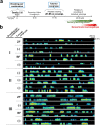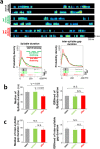Familial bias and auditory feedback regulation of vocal babbling patterns during early song development
- PMID: 27444993
- PMCID: PMC4957237
- DOI: 10.1038/srep30323
Familial bias and auditory feedback regulation of vocal babbling patterns during early song development
Abstract
Learned vocalizations are a crucial acoustic biosignal conveying individual traits in many species. Songbirds learn song patterns by listening to a tutor song and performing vocal practice during a sensitive developmental period. However, when and how individual differences in song patterns develop remain unknown. Here, we report that individual differences in vocal output exist even at the earliest song development stage, called subsong. Experiments involving the manipulation of both breeding pairs and song tutoring conditions revealed that the parental pair combination contributes to generating familial differences in syllable duration and variability in the subsong of offspring. Furthermore, after deafening, juveniles immediately changed their subsong by shortening the syllable durations but maintained the individual variability of their subsong temporal patterns, suggesting both auditory-sensitive modification and independent intrinsic regulation of vocal output. These results indicate that the temporal patterns of subsong are not merely disordered vocalization but are regulated by familial bias with sensitivity to auditory feedback, thus generating individual variability at the initiation of vocal development.
Figures





Similar articles
-
Neural processing of auditory feedback during vocal practice in a songbird.Nature. 2009 Jan 8;457(7226):187-90. doi: 10.1038/nature07467. Epub 2008 Nov 12. Nature. 2009. PMID: 19005471
-
Learning to breathe and sing: development of respiratory-vocal coordination in young songbirds.J Neurophysiol. 2011 Oct;106(4):1747-65. doi: 10.1152/jn.00247.2011. Epub 2011 Jun 22. J Neurophysiol. 2011. PMID: 21697438 Free PMC article.
-
Regulation of learned vocal behavior by an auditory motor cortical nucleus in juvenile zebra finches.J Neurophysiol. 2011 Jul;106(1):291-300. doi: 10.1152/jn.01035.2010. Epub 2011 Apr 27. J Neurophysiol. 2011. PMID: 21525374
-
Auditory experience and adult song plasticity.Ann N Y Acad Sci. 2004 Jun;1016:208-21. doi: 10.1196/annals.1298.017. Ann N Y Acad Sci. 2004. PMID: 15313777 Review.
-
Producing song: the vocal apparatus.Ann N Y Acad Sci. 2004 Jun;1016:109-29. doi: 10.1196/annals.1298.041. Ann N Y Acad Sci. 2004. PMID: 15313772 Review.
Cited by
-
A predisposed motor bias shapes individuality in vocal learning.Proc Natl Acad Sci U S A. 2024 Jan 16;121(3):e2308837121. doi: 10.1073/pnas.2308837121. Epub 2024 Jan 10. Proc Natl Acad Sci U S A. 2024. PMID: 38198530 Free PMC article.
References
-
- Marler P. & Slabbekoorn H. Nature’s Music: The Science of Birdsong (Elsevier Academic Press, 2004).
-
- Immelmann K. In Bird Vocalizations (ed Hinde R. A.) 61–74 (Cambridge University Press, 1969).
-
- Zann R. The Zebra Finch: A Synthesis of Field and Laboratory Studies (Oxford University Press, 1996).
Publication types
MeSH terms
LinkOut - more resources
Full Text Sources
Other Literature Sources
Molecular Biology Databases

